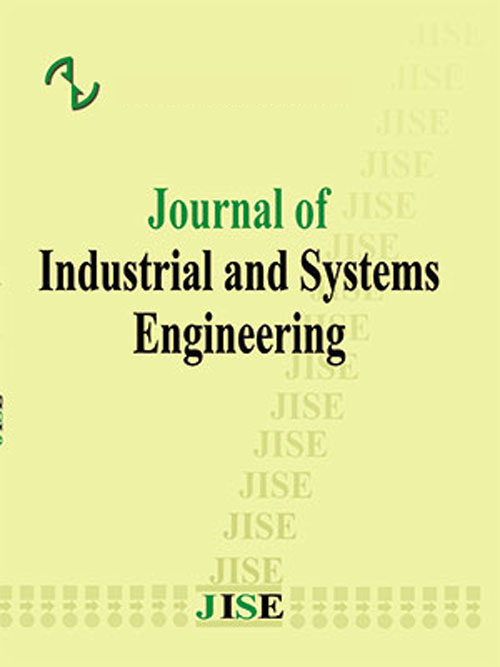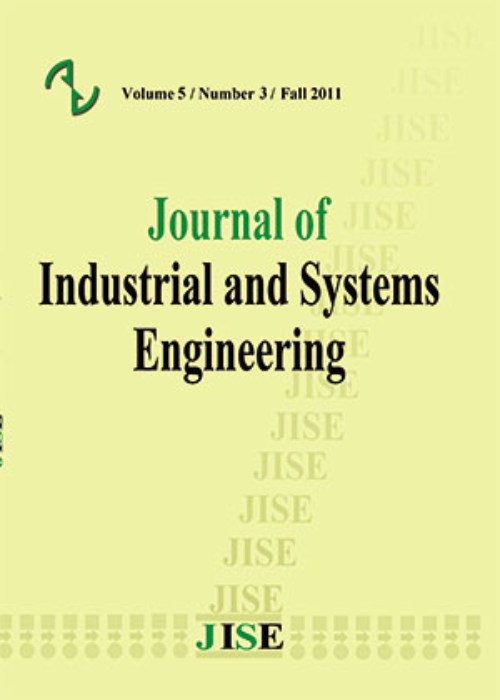فهرست مطالب

Journal of Industrial and Systems Engineering
Volume:8 Issue: 4, Autumn 2015
- تاریخ انتشار: 1394/09/21
- تعداد عناوین: 7
-
-
Pages 1-18Strategic decisions in a supply chain are the most important decisions for petroleum production systems. These decisions, due to high costs of transportation and storing, are costly and affected by the tactical and operational decisions in uncertain situations. In this article, we focus on designing a downstream segment for a supply chain of petroleum production systems. For this purpose, we will propose a two- stage approach considering a hierarchical structure, including the mathematical optimization model for determining strategic decisions in a leader problem and a simulation model for determining tactical and operational decisions in a follower problem. In the first stage, strategic decisions are made by solving a new mathematical model to obtain the location of depots and their capacities, transportation facilities, the volume of annual production, annual flow from refinery to depots and from depots to markets regions. In the second stage, we face some queuing systems where we aim to determine the number of loading and unloading platforms and order volume. Finally, the proposed model is applied in a real-world problem. The results show the suitable performance of the proposed model.Keywords: Supply Chain, petroleum production systems, simulation, based optimization
-
Pages 19-38Supplier selection can be considered as a complicated multi criteria decision-making problem.In this paper the problem of supplier selection is studied in the presence of conflicting evaluations and insufficient information about the criteria and different attitudes of decision makers towards the risk. Most of fuzzy approaches used in multi-criteria group decision making (MCGDM) are non-intuitionistic, which significantly restricts their application areas. Because of considering belongingness and non-belongingness of the issue in a same time, intuitionistic fuzzy sets can better encounter with a real supplier selection problem. Also to deal with different attitudes of decision makers toward the risk, the proposed approach in this paper employs a new decision function to participate this factor in decision process. In order to integrate fuzzy information, interval-valued intuitionistic fuzzy ordered weighted aggregation (IIFOWA) is applied to aggregate the obtained preferences. The influence of unfair arguments in final results can be reduced by assigning low weights to the “optimistic” or “pessimistic” discretions. Ranking process is based on the two indices, weighted score function and weighted accuracy function. To demonstrate the efficiency of the proposed approach, it is implemented to supplier selection in a project-based company.Keywords: Multi, Criteria Group Decision Making, Supplier Selection, Interval, Valued Intuitionistic Fuzzy Set, Aggregation Operator, Risk Attitude, Decision Function
-
Pages 39-60In this article the coordination of pricing and cooperative advertising decisions in one-manufacturer one-retailer decentralized supply chain with different market power for channel members is studied. The products are both perishable and substitutable. The problem is modeled as a nonlinear bi-level programming problem to consider both retailer and manufacturer decisions about prices and advertisement expenditure as well as the amount of retailer’s purchase. An Improved Particle Swarm Optimization through combining PSO by local search and diversification is proposed to solve the model. Finally, a numerical example is presented to analyze the effect of market scale. Also the role of the values of coefficient of price elasticity on decisions is studied via the numerical example. Numerical results indicate that to raise profit when the consumers are more price-sensitive, both the manufacturer and the retailer should decrease their prices and increase their advertising expenditure. In the larger market scale, the manufacturer and the retailer are even permitted to increase their prices to gain more profit.Keywords: Bi, level programming, Pricing, Multi, product supply chain, Substitutable, perishable products, Cooperative advertising, Market power
-
Pages 61-73In the realm of scheduling problems, different sources of uncertainty such as probabilistic durations of jobs or stochastic breakdowns of machines can arise. Given this, one highly desirable characteristic of an intelligent schedule is to bring better punctuality with less efficiency-loss because a dominant factor in customer appreciation is punctuality. It is also one of the most intangible topics for managers when a due date is predetermined to deliver jobs. In this paper, we address the β-robust job shop scheduling problem when the processing time of each operation is a normal random variable. We intend to minimize the deviation of makespan from a common due date for all jobs which corresponds to maximizing the service level, defined as probability of the makespan not exceeding the given due date. We develop a branch-and-bound algorithm to solve the problem. Using a set of generated benchmark instances, the performance of the developed algorithm has been evaluated.Keywords: Job Shop, Stochastic scheduling, Branch, and, bound algorithm
-
Pages 74-88The growth of AVL (Automatic Vehicle Location) systems leads to huge amount of data about different parts of bus fleet (buses, stations, passenger, etc.) which is very useful to improve bus fleet efficiency. In addition, by processing fleet and passengers’ historical data it is possible to detect passenger’s behavioral patterns in different parts of the day and to use it in order to improve fleet plans. In this research, a new approach is developed to use AVL data to investigate relationship between headway change and passenger downfall rate. For this purpose, a new method is developed that is called Intelligent Headway Selection (IHS) approach. The aim of this approach is finding similar days from passengers’ behavior perspective in the dataset and by focusing on unusual patterns of each group, headway changes effects on passenger downfall rate is being studied. In this approach, in the first step, each day is classified into specific time periods (like half of hours) and the passengers’ behavior pattern is detected for each day during the specified time periods. Then, in the K-Means algorithm, Euclidian distance measure is replaced with Dynamic Time Warping (DTW) algorithm to enable the K-Means to compare time series. The modified K-Means algorithm is used to compare days in the dataset and categorize similar days in the same clusters. Then, headway – passenger per minute plot is created for each time period to detect unusual patterns. Then, a Headway Interval Detection Procedure (HIDP) is developed to use these unusual patterns to find suitable headway values for each time period. Afterwards, these plots merged and the final headways are calculated.Keywords: Headway, AVL, Dynamic Time Warping (DTW), Data mining, k, means algorithm, Bus scheduling
-
Pages 89-107With progressing technologies and new features of production, new products compete with older ones in markets. Indeed, new products initiate contest with olden ones and this process repeats in different productions lifetime several times. In this situation recycling the olden products seems to be significant for supply chains. Governments often levy special tariffs for these products as a control tool which aims to incentive production recovery. In the real world, government purposes financial incentive plans for recoverable productions and also punitive plans for unrecoverable products. This paper tries to model the competition of a closed-loop supply chain and an ordinary supply chain using a game theory approach. In next step, the effects of persuasive and punitive governmental plans are modeled. Finally optimal retail and wholesale prices of the products are found in two chains. Numerical examples including sensitivity analysis of some key parameters will compare the results between different models of this study.Keywords: Game theory, competition, closed, loop supply chain, government intervention
-
Pages 108-123Training and adaption of employees are time and money consuming. Employees’ turnover can be predicted by their organizational and personal historical data in order to reduce probable loss of organizations. Prediction methods are highly related to human resource management to obtain patterns by historical data. This article implements knowledge discovery steps on real data of a manufacturing plant. We consider many characteristics of employees such as age, technical skills and work experience. Different data mining methods are compared based on their accuracy, calculation time and user friendliness. Furthermore the importance of data features is measured by Pearson Chi-Square test. In order to reach the desired user friendliness, a graphical user interface is designed specifically for the case study to handle knowledge discovery life cycle.Keywords: Employee's turnover, Data mining, human resource management, recruitment decision support system


